

"Where is the car?" I impatiently pressed Steve Janisse of Saab Cars USA as he twisted the cap off of a blue bottle of imported water. "Downstairs." Without further explanation, I headed for the elevator. I had waited for this moment long enough.
The ride down from the top floor of the Clift Hotel to the ground floor took forever. I reflected back at prior 9-3 models. The smooth lines. It's nimble feet on the track. It's powerful turbocharger. It's aircraft-like interior and sport seats. Both the 9-5 and 9-3 in my mind represent near-perfect Swedish performance. And Saab now promises further perfection upon that premise.
The bright silver finish of the wheels caught my eye at first. Parked near the curb at Geary Street, the contrast of the bright silver wheels against a satin silver finish was remarkable. It looked out of place amid the noise and congestion and traffic of downtown San Francisco.
The coupé-like silhouette, with steeply raked windshield and rear window and short front and rear overhangs, communicates a strong, sporty stance, which is reinforced by negative wheel cambers. The overall look is designed to convey a sense of movement even when the car is stationary. The shape of the windows and the wedge-like profile also combine with the sleek integrated headlights and grille to give the car its distinctive Saab identity.
It's lines and stance beckoned to me. "Let's hit the road - get out of here - let's drive."
Armed with maps, snacks and an appetite for the open road, the time had come to drive the new 9-3 on some of Northern California's finest back roads, then back again through traffic, and finally on an Autocourse track against BMW and Audi. So drive it I did.
Heading north out of the city, across the Golden Gate Bridge, I settled in and found comfort in the seats and the familiar Saab layout. Nothing goofy or awkward about the new 9-3, its Saab DNA clearly speaks to the driver - its what this car is all about. What's new is subtle and necessary - improved controls for the radio and digital readouts. Its driving dynamics are a dramatic improvement over the prior 9-3, with its quick and behaved throttle response, precise steering and eyeballs-popping-out-of-your-head braking. Winding through the back roads of Marin County, the 9-3 dutifully dove into the apex and its turbo boosted at just the right moment at the exit of each turn. It's surefooted and sure, forgiving and responsive.
Sunroof and throttle wide open, we headed back to the city for the shootout on the Autocourse with BMW's 3-series and Audi's A4. Both were equipped as our Saab - in two-wheel drive configuration with similar powerplants and tires. On the track, my time in the 9-3 bested that of the two competitor cars that I drove by over four seconds (on a course that took about 58 seconds to lap). Even so, it's out on the open road, or even in city traffic, that the 9-3 shines over the BMW and Audi.
Knut Simonsson, Brand Director, Saab Automobile says the new Saab 9-3 Sport Sedan places Saab head-to-head against the established players within the premium compact sport sedan sector, offering a new, alternative, more self-expressive choice.
As Saab's first contender in the premium, compact sport sedan segment, the focus for the new 9-3 is dedicated to delivering a unique, fun-to-drive experience that promises to set new standards for the class. The new 9-3 four-door Sport Sedan replaces the former Saab 9-3 three-door coupe and five-door hatchback models. And it does not disappoint.
The new model comes with a choice of two new, 2.0-liter, all-aluminium turbocharged engines, ranging in power from 175 to 210 hp. The front-wheel-drive transmissions include five- and six-speed manual gearboxes and a five-speed automatic with Saab Sentronic® manual selection and the option of steering wheel controls. There are three 9-3 flavours - Linear, Arc, and Vector.
"Linear" features an understated interior with attractive leather upholstery and anthracite trim. "Arc" adds more luxury, with 16-inch alloy wheels and leather interior with poplar wood trim. "Vector" adds a sporty flair, with 17-inch alloy wheels and a sports leather interior with matte chrome trim. All three are excellent.
Compared to its predecessor, the new 9-3 offers more spacious accommodations, particularly for rear passengers, within the same overall length. Front and rear width is increased by 2.16 in. (55 mm) and the wheelbase is 2.8 in. (71 mm) longer. It is price-positioned to compete with the BMW 3-series, Audi A4, and Volvo S60.
Once called "the poster child" of torque-steer, the 9-3 has so thoroughly rid itself of this characteristic that it's nonexistent. Kevin Smith of Saab Cars USA explains that the original 9-3 and the Viggen never suffered from real torque steer in the first place, but rather from unequal grip at the nose at hard throttle due to weight transfer. However defined, it was bad, and even worse on the track. This iteration of the 9-3 is a whole different and better car - in that, and every other respect.
During the early development stages of the new 9-3 Sport Sedan, Saab's chief chassis engineer, Ekkehard Schwartz, was asked to describe the car's core appeal. His immediate response was a quick sketch, but not of the car itself. He drew the image of an exhilarated driver.
The whole idea, Schwartz explained, was to build the car around the driver, focusing on achieving a rewarding, interactive experience behind the wheel. Every element of the design of the new Saab 9-3, therefore, aims to enhance communication to and from the car, involving rather than insulating the driver. That includes the design of the chassis, the powertrain, the steering, all controls and the immediate driver's environment, the cockpit of the car.
The key element of the sketch is the big grin to the driver's face, Schwartz emphasized. The pure joy of driving is, ultimately, what it's all about. Schwartz' original sketch has now been adopted as the central image in an international marketing campaign to announce the arrival of Saab's first compact sports sedan. "My artistic abilities may be rather limited, but it is clearly the message that counts," he noted. "Although I think I'll stick to my career in chassis development work."
Built on the now-famous Epsilon platform that is shared in Europe with Opel and soon in the USA on the new 2004 Chevrolet Malibu, the main features of the new 9-3 contribute to an enriched, sporty driving experience in driver involvement, refined performance, driver adaptability and driver-centred design.
Saab's entry into the premium, compact sport sedan segment is being complemented by the development of a new marketing and retail strategy, Saab Unlimited. At the start of sales, 300 dealerships in major markets around the world will have been upgraded and appointed in prime locations as Unlimited Partners. The branded style of these facilities and the services provided will meet the highest standards of customer care. At a small number of prestigious, cosmopolitan locations, there will also be city centres, aimed at taking the Saab brand out to where potential customers work, travel, shop or simply socialize. These sites are designed to give Saab optimum exposure as shop windows for the brand.
Longer service intervals and reduced maintenance times minimize inconvenience for the owner. Vehicles are covered under the Saab No Charge Scheduled Maintenance Program for 3 years or 36,000 miles, whichever comes first, for factory-recommended scheduled maintenance performed at an authorized Saab dealer in North America.
RIVALS
Saab seeks to move into the top-rung with cars like Audi A4, BMW 3-series, and I think even Mercedes-Benz C-Class. Compare also to the Volvo S60.
US MARKET PRICING
Saab 9-3 Models, suggested retail prices. Prices and equipment vary, see dealer for details. Not including shipping, government fees and taxes:
9-3 SE Convertible - $39,995
9-3 Linear Sport Sedan - $25,900 (Vehicle tested for this review).
9-3 Arc Sport Sedan - $29,995
9-3 Vector Sport Sedan - $32,495
HIGHS
Saab has killed torque-steer, and it's bones are dry. Saab DNA in the new 9-3 is intact.
LOWS
The Viggen is gone, but the Vector promises exhilarating performance.
FUEL ECONOMY
Not available at press time, but our testing revealed a range of about 23-mpg to 28-mpg.
FOR MORE INFORMATION
Visit Saab USA online at: www.saabusa.com
Saab UK: www.saab.co.uk
Road test: 2003 Saab 9-3 Linear 2.0T
Story by Vincent Bodiford
Vincent Bodiford is our North American correspondent, and is the Automotive Editor of www.theweekenddrive.com amongst other things. Note that most cars reviewed by Vincent will be US specification. However, there are few differences these days and we will do our utmost to point out what to expect from the UK/European equivalents.
|

|
|
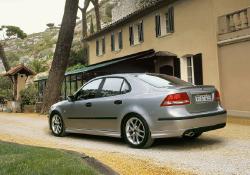
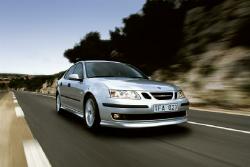
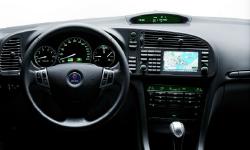
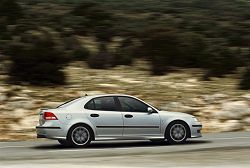
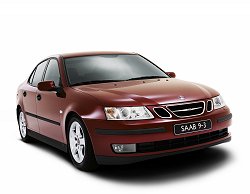
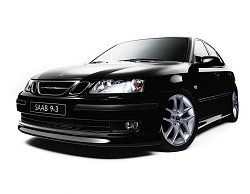
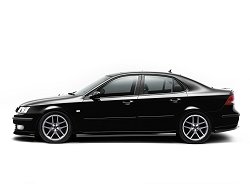
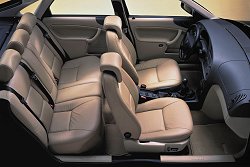
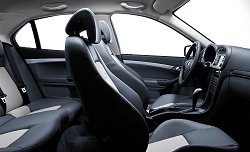
|








